
Mallard
Anas platyrhynchos
Passéeriforme Order – Anatidae Family
BIOMETRICS :
Length : 50-65 cm
Wingspan : 75-100 cm
Weight : 750 gr – 1, 600 kg
DESCRIPTION:
Mallard is the commonest of all ducks. This species is widespread and found from towns to isolated rivers.
It is a large dabbling duck, very common in all kinds of waters.

Mallard adult male in breeding plumage has grey body. On the upperparts, back is dark grey. Lower back, rump and uppertail coverts are black. Upperwing is grey with blue speculum. The rounded tail is black in the centre, whereas the outer rectrices are white. We can see some black curled tail feathers.
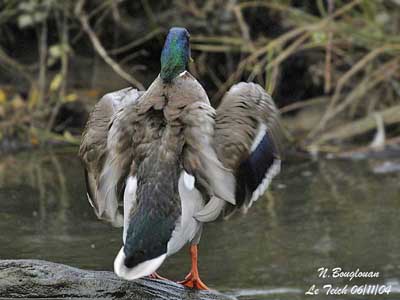
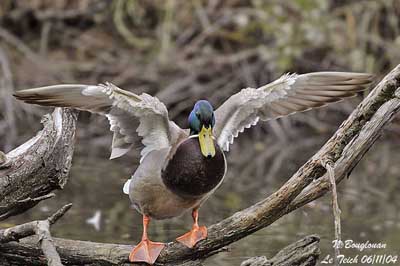
On the underparts, breast is purple-brown. The rest of the underparts is pale brownish-white. Underwings are whitish. Undertail is black and white.
The head is iridescent bottle-green, separated from the body by narrow white collar. The bill is olive to yellow. Eyes are dark brown. Legs and webbed feet are orange.
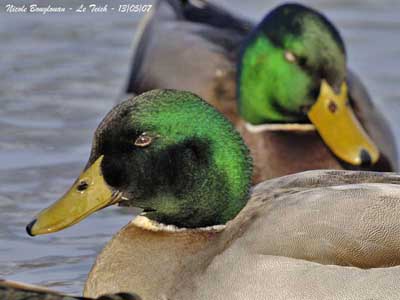
Male in eclipse plumage resembles female, but it has greenish-yellow bill.
Female has brown plumage with blackish-brown edged feathers. She has blue speculum bordered by white bands. The bill is grey with orange tinge.
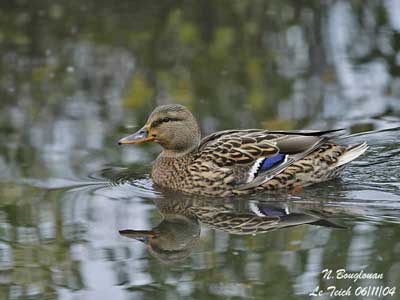
Chicks are brown with yellowish cheeks and supercilium, black eye-stripe and buffy-white underparts.
Juvenile is similar to female but darker, with heavily streaked underparts. Young male has brown bill.

We can find seven subspecies which vary in size and colours.
Mallard may sometimes show strange-looking due to domestication and hybridization. We also find pure white ducks.
VOICE: SOUNDS BY XENO-CANTO
Mallard is very vocal, mainly female.
Male utters soft, weak, nasal note “raehb”.
Female often gives typical quacks which are uttered in series descending towards the end “QUACK-QUACK-QUACK-quack-quack-quack…”
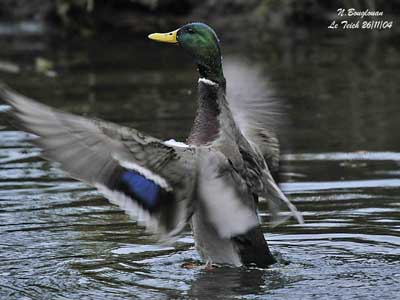
HABITAT:
Mallard is found in all kinds of wetlands with fresh, brackish or salt waters. It needs shallow waters with vegetation for cover.
This species is very common in urban parks. Outside breeding season, it may be found in estuaries, sheltered bays, and coasts, and mainly in lowlands.
RANGE:
Mallard is widespread and found in northern hemisphere except tundra, high mountains and deserts. The species has been introduced in Australia and New Zealand.
The northern populations can migrate southwards after breeding season, but if the food resources are abundant, some populations are resident.
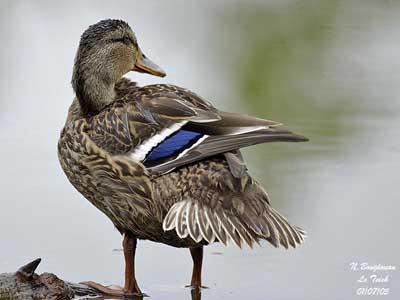
BEHAVIOUR:
Mallard is a dabbling duck. It is omnivorous, feeding in groups. It performs “head-dipping” and “up-ending” while swimming to reach the food in deeper water.
It feeds on aquatic vegetation, invertebrates and sometimes amphibians and fish. It may graze on land.
These birds gather in large flocks outside breeding season.
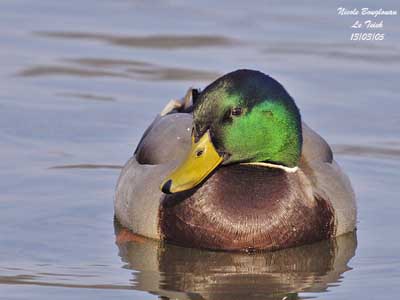
Mallard is usually shy and wary, but in urban habitat, it may become very tame, taking advantage of humans for food.
Pair forms in late autumn. Male starts to display in the early spring. A new pair is formed each season. Pair-bonds are broken after egg-laying. The mates of a new pair fly to the breeding area together, and are ready to breed very quickly when they reach the nesting-site.
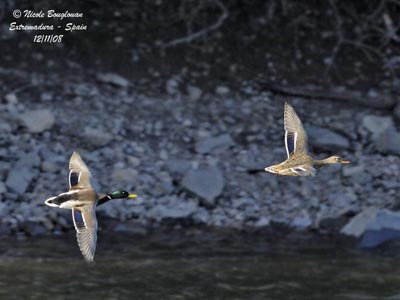
Usually, female starts the displays among several males, performing “head-nodding” while swimming in circles and adopting a flat posture. Male responds by other posture with retracted head, erected plumage and stretched out body. Then, male shakes strongly its plumage. It bends the neck and utters a loud whistle followed by a grunting sound, just before to recover its original attitude.
At the end, the males perform a “head-up-tail-up” directed towards the selected female. Usually, copulation occurs on the water.
After the egg-laying, male abandons the female which assumes all the nesting duties alone.
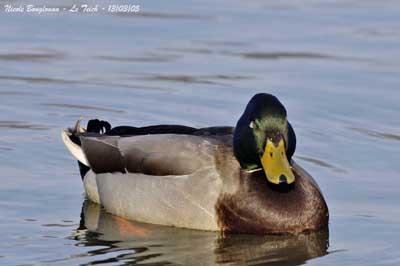
FLIGHT:
Mallard is a good flier. The pointed wings are very powerful, allowing wide wing-beats for this heavy duck. It takes flight fairly easily from water, and also alights on water with feet lowered and the webs fully spread before the contact.
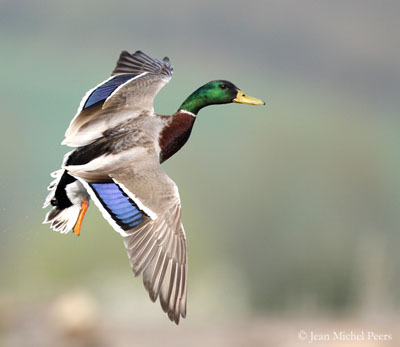
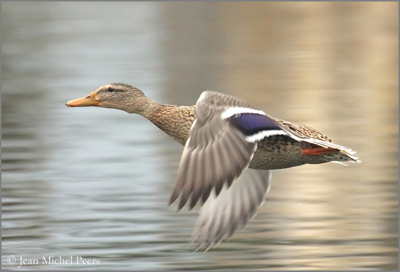
REPRODUCTION:
Breeding season occurs mainly between February and June, but it varies according to the geographic range.
Mallard may nest alone or in loose groups. The nest is on the ground, hidden among vegetation or in natural cavities in trees or others.
Nest is a bowl-shaped depression made with grass. Interior is lined with feathers and down.
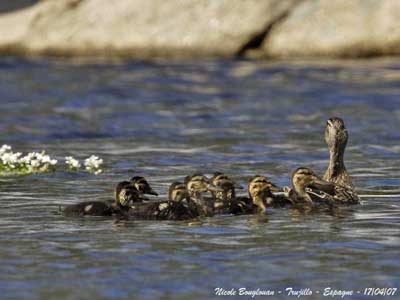
Female lays 4 to 18 eggs, in average 9 to 13. Incubation lasts about 27-28 days. Chicks are precocial and able to leave the nest very soon after hatching. They can feed alone and swim as soon as their downy body is dry. The first two days, they remain close to the nest. Later, they follow their mother which cares and rears them alone until they are fully feathered, at about 50-60 days after hatching.
They reach their sexual maturity at one year.
This species produces one clutch per year, but may replace the brood if nest-failure occurs.
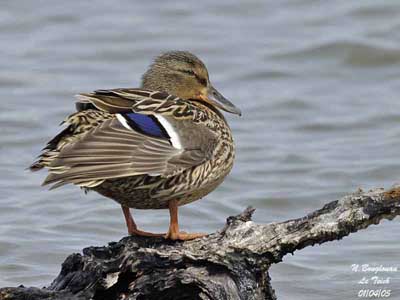
DIET:
Mallard is omnivorous. It feeds on seeds and parts of aquatic plants, terrestrial and aquatic invertebrates (insects, crustaceans, molluscs and worms), and sometimes amphibians and fish. They feed by swimming along, dabbling and up-ending, and they may graze on the ground.
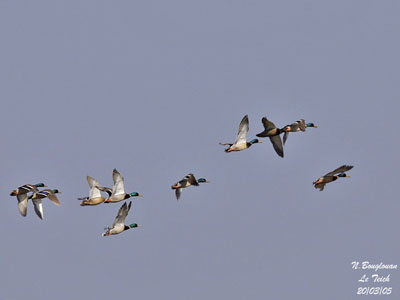
PROTECTION / THREATS / STATUS:
Mallard is probably the most widespread of all the duck’s species.
They are well adapted to humans, taking advantage for food. This species is also a common game bird in its wide range, but populations are not globally threatened, in spite of habitat loss by changes in wetlands throughout the range.
Fr: Canard colvert
All : Stockente
Esp : Anade Real
Ital: Germano reale
Nd: Wilde Eend
Russe: Кряква
Sd: Gräsand
Photographs of flying Mallards (male and female) by Jean Michel Peers
His website : JMPN PHOTOGRAPHIE
Photographs and text by Nicole Bouglouan
Sources :
HANDBOOK OF THE BIRDS OF THE WORLD vol 1 by Josep del Hoyo-Andrew Elliot-Jordi Sargatal - Lynx Edicions - ISBN: 8487334105
THE HANDBOOK OF BIRD IDENTIFICATION FOR EUROPE AND THE WESTERN PALEARCTIC by Mark Beaman, Steve Madge - C.Helm - ISBN: 0713639601
L’ENCYCLOPEDIE MONDIALE DES OISEAUX - Dr Christopher M. Perrins - BORDAS - ISBN: 2040185607
GUIDE DES CANARDS, DES OIES ET DES CYGNES – de Steve Madge - Delachaux et Niestlé - ISBN: 2603013769
THE COMPLETE BOOK OF BRITISH BIRDS – Written by “Royal Society for the Protection of Birds” experts - Préface de Magnus Magnusson - Michael Cady- Rob Hume Editors - ISBN: 0749509112